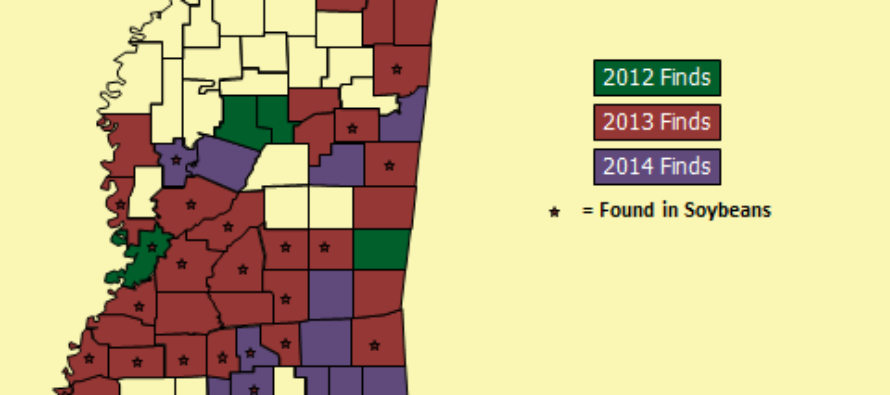Management of Kudzu Bugs in Mississippi Soybeans

By now most folks have heard of Kudzu bugs. In fact, we have now confirmed them in 52 counties in Mississippi. Kudzu bugs, Megacopta cribraria, was first found in Georgia in 2009. Since that time it has spread rapidly across the southeast  and is now moving west in to Mid-southern states. It was first found in Mississippi in 2012 and now covers most of the state. As the name implies, it feeds on kudzu but also is a pest of soybeans, and once well established will likely require treatment at some point in the season. In 2013 we estimated that that ~2500 acres were treated below I20 for this pest. There have already been a few isolated fields treated in the southern part of the state this year and I expect that number will rise as we move into August. Another huge potential problem with this pest is that it seeks out protected places to overwinter and often invades houses in very high numbers similar to what many in Mississippi have experienced with lady beetles in the fall.
and is now moving west in to Mid-southern states. It was first found in Mississippi in 2012 and now covers most of the state. As the name implies, it feeds on kudzu but also is a pest of soybeans, and once well established will likely require treatment at some point in the season. In 2013 we estimated that that ~2500 acres were treated below I20 for this pest. There have already been a few isolated fields treated in the southern part of the state this year and I expect that number will rise as we move into August. Another huge potential problem with this pest is that it seeks out protected places to overwinter and often invades houses in very high numbers similar to what many in Mississippi have experienced with lady beetles in the fall.
Identification and Biology: Kudzu bugs are fairly easy to identify. Adults are roughly the size of a pencil eraser, hard bodied, with a “flat” rear end. At first glance it may appear stink bug like. Egg masses are laid in rows of 2. Nymphs go through 5 instars and have a “hairy or spiny” appearance. Egg to adult is roughly 6 weeks. There appears to be 2 generations a year in the Mid-south at this time.

Photo: Joe Eger, Dow AgroScience, Bugwood.org
Host Plants: most legumes including kudzu, soybean, wisteria.
Pest Status: Kudzu bugs have piercing sucking mouthparts and feed by sucking sap from the plant so you will not see holes in the leaves from this pest. Fortunately they do not feed directly on the fruit. Feeding tends to be restricted to stems and petioles. Yield loss results from very high numbers reducing overall vigor similar to what we observe with false chinch bugs. However, it is not uncommon to observe VERY HIGH numbers, especially on field edges. Research from the southeast has shown yield loss as high as 60% with and average of around 20% where left untreated.

Photo By: Phillip Roberts, University of Georgia, Bugwood.org
Threshold: Our colleagues in the southeast have been researching kudzu bugs since they arrived in 2009. Based on their findings, thresholds are 5 adult kudzu bugs per plant in vegetative stages and 25 nymphs per 25 sweeps in reproductive stages in soybeans.The reason it is not recommended to treat larger beans on adult numbers is that the migration into the field can last 4-6 weeks and retreatment will likely be necessary if you spray too early. If you wait on the nymphs, it is an indication that the adult migration is over and you can likely get away with one application. Remember, 10, 15, or even 25 adults per 25 sweeps is not a lot!
Control: Pyrethroids typically provide the best control of this pest, especially bifenthrin. Acephate also provides decent control at the 0.75 lb rate.






Let me tell You a sad story ! There are no comments yet, but You can be first one to comment this article.
Write a comment